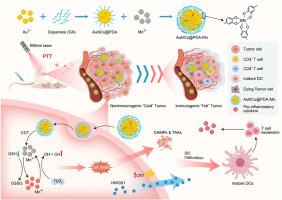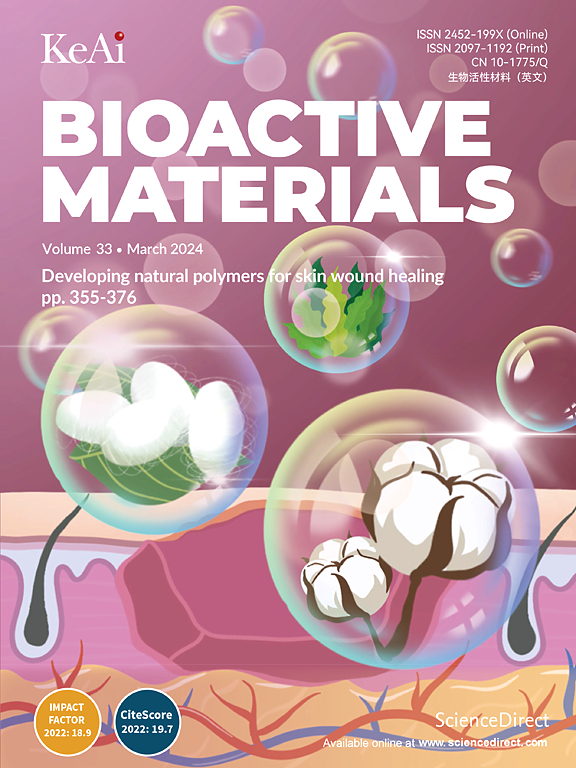Metal-phenolic-network-coated gold nanoclusters for enhanced photothermal/chemodynamic/immunogenic cancer therapy
IF 18
1区 医学
Q1 ENGINEERING, BIOMEDICAL
引用次数: 0
Abstract
Triple-negative breast cancer (TNBC) is the most aggressive subtype of breast cancer, characterised by a short survival period, high malignancy, strong invasiveness, and high rates of recurrence and metastasis. Due to its unique molecular phenotype, TNBC is insensitive to endocrine therapy or molecular targeted therapy. The conventional treatment approach involves systemic chemotherapy for overall management; however, adjuvant chemotherapy after surgery has shown poor efficacy as residual lesions can easily lead to tumour recurrence. Therefore, there is an urgent need to find more effective treatment strategies. Herein, we designed a gold nanocluster coated with a metal-phenol formaldehyde network structure (AuNCs@PDA-Mn) for tumour Photothermal therapy and chemodynamic therapy (PTT and CDT), which induces systemic immune responses to suppress tumour metastasis. Experimental results show that after continuous irradiation for 10 min under an 808 nm laser (1.0W/cm2), AuNCs@PDA-Mn not only exhibits better tumour inhibition both in vitro and in vivo but also triggers stronger immune effects systemically. Therefore, this combined PTT and CDT treatment approach has great potential and provides a clinically relevant and valuable option for triple-negative breast cancer.

用于增强光热/化学动力/免疫性癌症治疗的金属酚网络包覆金纳米团簇
三阴性乳腺癌(TNBC)是乳腺癌中最具侵袭性的亚型,其特点是生存期短、恶性程度高、侵袭性强、复发率和转移率高。由于其独特的分子表型,TNBC 对内分泌治疗或分子靶向治疗不敏感。传统的治疗方法是采用全身化疗进行整体治疗,但术后辅助化疗的疗效不佳,因为残留病灶很容易导致肿瘤复发。因此,迫切需要找到更有效的治疗策略。在此,我们设计了一种包覆金属-苯酚甲醛网络结构的金纳米簇(AuNCs@PDA-Mn),用于肿瘤光热疗法和化学动力疗法(PTT和CDT),诱导全身免疫反应以抑制肿瘤转移。实验结果表明,在808纳米激光(1.0瓦/平方厘米)下连续照射10分钟后,AuNCs@PDA-Mn不仅在体外和体内都表现出更好的肿瘤抑制效果,而且还能引发更强的全身免疫效应。因此,这种结合 PTT 和 CDT 的治疗方法具有巨大的潜力,为三阴性乳腺癌提供了一种具有临床相关性和价值的选择。
本文章由计算机程序翻译,如有差异,请以英文原文为准。
求助全文
约1分钟内获得全文
求助全文
来源期刊

Bioactive Materials
Biochemistry, Genetics and Molecular Biology-Biotechnology
CiteScore
28.00
自引率
6.30%
发文量
436
审稿时长
20 days
期刊介绍:
Bioactive Materials is a peer-reviewed research publication that focuses on advancements in bioactive materials. The journal accepts research papers, reviews, and rapid communications in the field of next-generation biomaterials that interact with cells, tissues, and organs in various living organisms.
The primary goal of Bioactive Materials is to promote the science and engineering of biomaterials that exhibit adaptiveness to the biological environment. These materials are specifically designed to stimulate or direct appropriate cell and tissue responses or regulate interactions with microorganisms.
The journal covers a wide range of bioactive materials, including those that are engineered or designed in terms of their physical form (e.g. particulate, fiber), topology (e.g. porosity, surface roughness), or dimensions (ranging from macro to nano-scales). Contributions are sought from the following categories of bioactive materials:
Bioactive metals and alloys
Bioactive inorganics: ceramics, glasses, and carbon-based materials
Bioactive polymers and gels
Bioactive materials derived from natural sources
Bioactive composites
These materials find applications in human and veterinary medicine, such as implants, tissue engineering scaffolds, cell/drug/gene carriers, as well as imaging and sensing devices.
 求助内容:
求助内容: 应助结果提醒方式:
应助结果提醒方式:


